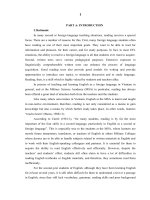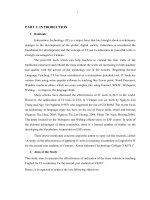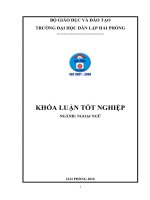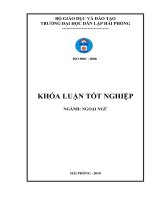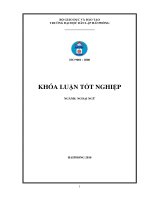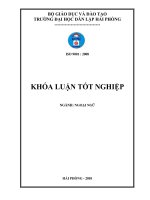A STUDY ON EFFECTIVENESS OF APPLICATION INFORMATION TECHNOLOGY TOOLS IN TEACHING ENGLISH FOR IT VOCABULARY FOR SECOND YEAR STUDENTS AT VIETNAM KOREA INDUSTRIAL TECHNOLOGY COLLEGE
Bạn đang xem bản rút gọn của tài liệu. Xem và tải ngay bản đầy đủ của tài liệu tại đây (647.94 KB, 42 trang )
<span class="text_page_counter">Trang 1</span><div class="page_container" data-page="1">
<b>PART 1: INTRODUCTION</b>
<b>1. Rationale</b>Information Technology (IT) is a major force that has brought about revolutionary changes in the development of the global, digital society. Education is considered the foundation for development and the concept of IT use in education as powerful tools is strongly encouraged in Vietnam.
The powerful tools which can help teachers to expand the four walls of the traditional classroom and rebuild the class without the walls are increasing in both quantity and quality with the advent of the technology era in the country. Regarding Second Language Teaching,
IT
has been considered as a tremendous potential tool. IT tools are various from using some popular software in teaching like Power point, Word Processor, Window media to others which are more complex like using Internet, WWW, Webquest, Weblog… to improve the language skills.Many articles have discussed the effectiveness of IT tools in SLT in the world. However, the application of IT tools in ESL in Vietnam was set forth by Nguyen Lan Trung and Ngo Van Nghiem (1997) who suggested the use of CD-ROM. The recent focus on technology in language study has been on the use of Power point, email and Internet (Nguyen Thu Hoai, 2005; Nguyen Thi Lan Huong, 2004; Pham Thi Ngoc Phuong,2006). The latest focused on the Webquest and Weblog effectiveness in ESP course. In spite of the claimed advantages of these researches, there is a limited number of studies on the developing the Vocabulary Acquisition in ESP course.
These above-mentioned concerns urged the author to carry out the research, called: “A study on the effectiveness of applying IT tools in teaching Vocabulary in English for IT for the second year students at Vietnam – Korea Industrial Technology College (VKITC)”
<b>2. Aims of the Study</b>
This study aims to measure the effectiveness of utilization of the class website in teaching English for IT vocabulary for the second year students at VKITC.
Hence, it is expected to achieve the two following objectives:
</div><span class="text_page_counter">Trang 2</span><div class="page_container" data-page="2">- First, to investigate the influence of utilizing class website on the vocabulary outcomes of the second year students in English for IT Course at Vietnam Korea College.
- Second, to investigate the learners’ opinions and attitudes towards the application of class website in ESP vocabulary teaching.
- Third, to find out the difficulties students meet during the course.
<b>3. Research Questions</b>
In order to achieve the aims of the study, the following research questions were raised: 1. To what extent does the employment of class website have influence on the
effectiveness of teaching IT vocabulary for the 2<small>nd</small> year students in IT Faculty at VKITC?
2. What are the students’ opinions and attitudes towards the utilization of the class website in their IT vocabulary learning?
3. What difficulties do students meet during the employment of the class website to improve their vocabulary acquisition?
<b>4. Scope of the Study</b>
The present study operates within the following scope:
(i) A study on the application of IT tool in ELT is a broad topic, hence, in this research, the author decides to choose a specific IT tool to study, it is designing a website for the course. (ii) By the time constraint, making a research with a large number of the participants was out of the author’s reach, hence, the participants for the study was 40 students from 105 students at IT Faculty at VKITC.
<b>5. Methods of the study</b>
The method used in this study is quasi-experimental research design which utilizes both qualitative and quantitative data collection techniques. The writer, who created IT Vocabulary Program, designed a website for the class. The data collected for the study is from the pretest and posttest, online survey questionnaires.
</div><span class="text_page_counter">Trang 3</span><div class="page_container" data-page="3">
<b> 6. Significance of the Study</b>
The first significance of the study is for the author herself and for the other ESL teachers in VKITC since the data collected from the study can be analyzed and interpreted in terms of using website to promote the effectiveness of ESP teaching at this College.
The results of the study are also expected to English language teachers who have interest in applying new technology in their classroom for higher teaching quality. Especially, the teachers who are teaching English for IT in colleges or university can use the materials, worksheets, sites in the Nicemoon’s class website (the term “Nicemoon” and the website was created by the researcher of this study) for their teaching with their own teaching purposes.
The last but not least significance of the study lies in the fact that it can lay grounds for further researches on the employment of Website-based activities in ESP as well as in General English teaching and learning.
<b>7. Design of the Study </b>
The study consists of three main parts:
<i>Part one ‘Introduction’ introduces the rationale, the aims, the research questions of the</i>
study and the scope, the methods and significance are also presented in this chapter.
<i>Part two ‘Development’ consists of four chapters</i>
<i>Chapter one provides the literature review including the overview of CALL, Incidental</i>
vocabulary acquisition, the benefits of the Internet in Second language Education and the World Wide Web as a Second Language Teaching tool.
<i>Chapter two discusses the detailed procedures to the design of the Web-Based Program.Chapter three details a quasi-experimental research as the method of the study, the</i>
participants and the instruments to collect both qualitative and quantitative data.
<i>Chapter four presents results of the study, the findings in which research questions are</i>
addressed and implications are also presented in this Chapter.
<i>Part three ‘Conclusion’ summarizes the main issues touched upon so far in the study.</i>
Limitation and suggestion for further study are also discussed in this Chapter.
</div><span class="text_page_counter">Trang 4</span><div class="page_container" data-page="4"><b>PART B: DEVELOPMENT</b>
<b>CHAPTER 1: LITERATURE REVIEW</b>
This chapter introduces a brief review of the literature relevant to the study and is divided into four sections. The first sections briefs the history of Computer Assisted Language Learning (CALL), the second sections is an overview of incidental vocabulary acquisition, it continues by discussing the benefits of the Internet to second language learning, the last one looks at the World Wide Web as a tool in second language teaching.
<b>1.1. CALL </b>
<b> </b> Since the initial introduction of computers into the field of second/foreign language education, a large number of practitioners have concurred that this technology holds great potential for language learning (Levy, 1997; Muyskens, 1997; Pennington, 1996; Warschauer, 1996; Warschauer & Healey, 1998). This belief leads to what is known as Computer-Assisted Language Learning, more commonly referred to as CALL. Even though the field is still young, many language educators are endorsing its use as an essential component in language teaching. Embracing the use of computers seems to be due to the fact that computers are capable of performing multiple tasks and thus are more than simply text processors. The computer can organize, select, and present multiple sensory components.
Computer-Assisted Language Learning (CALL) is defined as ‘the search for and study of applications of the computer in language teaching and learning’
Among the concerns often raised in the domain of CALL is how to use the potential of a computer to enhance the language learning process and how to use different media types in teaching and learning. The concern has been narrowed to the investigation of the efficacy of presenting information using multiple modalities, such as text, audio, still picture, and dynamic videos in the field of SLA. An area that has recently received attention is the impact of glossing individual vocabulary via annotations embodied by different modes and media. Researchers were inspired by the premise that a variety of glosses for words in various modalities, such as printed text, graphics, dynamic video, and sound, might have differing capacities to facilitate vocabulary acquisition and retention.
</div><span class="text_page_counter">Trang 5</span><div class="page_container" data-page="5">(Chun & Plass, 1996; Davis & Lyman-Hager, 1997; Lyman-Hager, Davis, Burnett, & Chennault,1993; Martinez-Lage, 1997).
Though CALL has developed gradually over the last 30 years, “this development can be categorized in terms of three somewhat distinct phases which I will
<i>refer to as behavioristic CALL, communicative CALL, and integrativeCALL”(cf. Barson &</i>
Debski, in press).
<b>1.1.1. Behavioristic CALL </b>
The first phase of CALL, conceived in the 1950s and implemented in the1960s and 1970s, was based on the then-dominant behaviorist theories of learning. Programs of this phase entailed repetitive language drills and can be referred to as "drill and practice" (or, more pejoratively, as "drill and kill").
“Drill and practice” courseware is based on the model of computer as tutor (Taylor, 1980). In other words the computer serves as a vehicle for delivering instructional materials to the student. The rationale behind drill and practice was not totally spurious, which explains in part the fact that CALL drills are still used today. Briefly, according to Taylor, behavioristic CALL:
Repeated exposure to the same material is beneficial or even essential to learning A computer is ideal for carrying out repeated drills, since the machine does not get
bored with presenting the same material and since it can provide immediate non-judgmental feedback
A computer can present such material on an individualized basis, allowing students to proceed at their own pace and freeing up class time for other activities
In the late 1970s and early 1980s, behavioristic CALL was undermined by two important factors. First, behavioristic approaches to language learning had been rejected at both the theoretical and the pedagogical level. Secondly, the introduction of the microcomputer allowed a whole new range of possibilities. The stage was set for a new phase of CALL.
<b>1.1.2. Communicative CALL</b>
</div><span class="text_page_counter">Trang 6</span><div class="page_container" data-page="6">The second phase of CALL was based on the communicative approach to teaching which became prominent in the 1970s and 1980s. Proponents of this approach felt that the drill and practice programs of the previous decade did not allow enough authentic communication to be of much value.
One of the main advocates of this new approach was John Underwood, who in 1984 proposed a series of "Premises for 'Communicative' CALL" (Underwood, 1984, p. 52).
Several types of CALL programs were developed and used during this the phase of communicative CALL. According to Taylor & Perez (1989) there were three main types of CALL:
- Computer as tutor - Computer as stimulus
- Computer as tool or Computer as workhorse
On the face of things communicative CALL seems like a significant advance over its predecessor. But by the end of the 1980s, many educators felt that CALL was still failing to live up to its potential (Kenning &Kenning, 1990; Pusack & Otto, 1990; Roschoff, 1993). The challenge for advocates of CALL was to develop models which could help integrate the various aspects of the language learning process. Fortunately, advances in computer technology were providing the opportunities to do just that.
<b>1.1.3. Integrative CALL</b>
Integrative approaches to CALL are based on two important technological developments of the last decade-multimedia computers and the Internet.
Multimedia technology--exemplified today by the CD-ROM-- allows a variety of media (text, graphics, sound, animation, and video) to be accessed on a single machine.
Computer-mediated communication (CMC), which has existed in primitive form since the 1960s but has only became wide-spread in the last five years, is probably the single computer application to date with the greatest impact on language teaching.
</div><span class="text_page_counter">Trang 7</span><div class="page_container" data-page="7">Mark Warschauer stated: “Computer-mediated communication allows users to share not only brief messages, but also lengthy documents and also graphics, sounds, and video. Using the World Wide Web (WWW), students can search through millions of files around the world within minutes to locate and access authentic exactly tailored to their own personal interests. They can also use the Web to publish their texts or multimedia materials to share with partner classes or with the general public”
It is not hard to see how computer-mediated communication and the Internet can facilitate an integrative approach to using technology. The following example illustrates well how the Internet can be used to help create an environment where authentic and creative communication is integrated into all aspects of the course.
Students of English for Science and Technology in La Paz Mexico do not just study general examples and write homework for the teacher; instead they use the Internet to actually become scientific writers (Bowers, 1995; Bowers, in press). First, the students search the World Wide Web to find articles in their exact area of specialty and then carefully read and study those specific articles. They then write their own drafts online; the teacher critiques the drafts online and creates electronic links to his own comments and to pages of appropriate linguistic and technical explanation, so that students can find additional background help at the click of a mouse. Next, using this assistance, the students prepare and publish their own articles on the World Wide Web, together with reply forms to solicit opinions from readers. They advertise their Web articles on appropriate Internet sites (e.g. scientific newsgroups) so that interested scientists around the world will know about their articles and will be able to read and comment on them. When they receive their comments (by e-mail) they can take those into account in editing their articles for republication on the Web or for submission to scientific journals.
<b>1.2. Incidental vocabulary acquisition</b>
Second language (L2) acquisition depends crucially on the development of a strong vocabulary. In the second language acquisition (SLA) subdiscipline known as second language vocabulary acquisition (SLVA), researchers have focused their attention on the need for
</div><span class="text_page_counter">Trang 8</span><div class="page_container" data-page="8">second-language learners to optimize their vocabulary knowledge (see, for instance, Singleton, 1999; and Schmitt, 2000). In the last five years, the merits of a variety of methods of vocabulary development have been hotly debated, beginning, one might argue, with Nation’s (2001) work. At issue within SLVA has been the relative importance and efficacy of implicit, explicit and incidental learning mechanisms in the acquisition of L2 vocabulary.
Recently, incidental vocabulary learning has received renewed attention within SLVA research. Paribakht and Wesche (1999, p.176) suggest that “incidental vocabulary learning” occurs when “learners are focused on comprehending meaning rather than on the explicit goal of learning new words”. Proponents of incidental vocabulary learning often point to research results that demonstrate vocabulary acquisition in the absence of vocabulary-based directives from teachers or researchers. Often, exposure to vocabulary is thought to be sufficient to trigger acquisition.
Incidental vocabulary acquisition is defined as the “learning of vocabulary as the by-product of any activity not explicitly geared to vocabulary learning” (Hulstijn, 1995, p271). According to him, “picking up” of words and structures, simply by engaging in a variety of communicative activities, during which the learner’s attention is focused on the meaning rather than on the form of the language.
In another words, incidental vocabulary acquisition deals with reading texts or doing activities that are not directly related to learning vocabulary, or the purpose of the task is not made explicit, for example, the learner is given a text (containing new words) to read and told that he/she will be expected to recall the content of the text. The learner is then tested on his/her recall of the new words.
It should be noted that the very term "incidental learning" is open to different interpretations in the literature. In fact, the last few years have seen the blurring of distinction between the incidental and intentional vocabulary acquisition. Traditional studies of incidental vocabulary learning involve learners being told just to read for comprehension, recent twists to the incidental vocabulary learning concept have included more demanding tasks beyond reading such as looking up new words in dictionaries for comprehension (Laufer & Hill, 2000) and recalling and retelling what is read (Joe, 1998).
The present study thus bears a relation to the aforementioned studies. Ellis stated that “the meaning of a new word is acquired totally unconsciously as a result of abstraction from repeated exposures in a range of activated contexts” (Ellis, 1995, p.14). Very recently, the
</div><span class="text_page_counter">Trang 9</span><div class="page_container" data-page="9">hypothesis has been revised to take into account the incidental learning necessary for the pattern recognition that precedes implicit language learning (Ellis, 2005).
<b>1.3. Benefits of the Internet in Second Language Education </b>
In addition to the communication benefits of the Internet, the Internet can also be used to retrieve and access information. The World Wide Web is therefore a virtual library: it is an available world of information for the language learner. While the Internet offers numerous benefits to language learners and instructors, some are mentioned here in the context of language teaching and learning.
According to Shinghal, one of the most essential pedagogical principles of language teaching is one that emphasizes the study of language in a cultural context. It is believed that language and culture are interdependent. Understanding the culture of the target language enhances understanding of the language. To this end, Shinghal considered the Internet as a valuable resource to both teacher and learner.
Moreover, Shinghal stated that the Internet also serves as a medium for experiencing and presenting creative works. While students can peruse the information on the Net, they can also use it as a platform for their own work such as essays, poetry, or stories. Students therefore become not only consumers of content, but in fact generate the content.
As Mike (1996) describes, the use of the Internet has also been shown to promote higher order thinking skills. A language teacher, for example, may instruct learners to search for specific information. The information must be put together to make a complete and coherent which needs the synthesis process.
Furthermore, the Internet provides supplemental language activities which can provide students with additional practice in specific areas of language learning (Shinghal). These include reading tests and comprehension questions, grammar exercises pronunciation exercises possible through the available multimedia capabilities, vocabulary exercises. Teacher may recommend specific sites on the Web or students can search the Web for the sites.
</div><span class="text_page_counter">Trang 10</span><div class="page_container" data-page="10">Although the Internet is a vivid and helpful medium to make language learning more efficient, a successful result depends on how well a teacher implements and integrates it into classroom instruction. It is only due to the teacher’s clear understanding of objectives, planning of coherent activities, searching for relevant resources, creativity that make the Internet-based classes stimulating and valuable.
<b>1.4. The World Wide Web as a Second Language Teaching tool </b>
‘World Wide Web (WWW) represents a new concept in technology, the library on your desktop, the dictionary at your fingertips, the sound at your ear. There is nothing that we hear or see that will not be available through WWW’.
<small>(A. Sangster, ‘World Wide Web – What can it do for Education?’, Active Learning 2, 1995)</small>
The World Wide Web (or the Web) is one of the most accessible tools available for academics to use. Academics who wish to create simple computer-aided learning courseware often face the decision of whether they should go down the path of learning a multimedia-authoring tool and distributing the material on a CD-ROM or flash disk; or whether they should move to the Internet and utilize the multimedia and creative activities on the Web. They are confused in choosing what to do since using the Web in teaching has many advantages but also some disadvantages.
There are many advantages of the Web, for instance, one has access to a Web server, publication is free, and once published, the material is made available to an international audience amounting to millions. However, accessing on networks is slow, and by opening up access to an international audience there are serious implications for copyright issues, these are some problems of the Web that academics may deal with.
The Web offers various opportunities for the academic who wishes to mount pedagogical materials via the Internet. According to Stuart Lee (2005), one of the best ways to get out of these troubles is creating a class website; this will act as a focal point for students to come to, detailing course time and changes and so on. An example of this is Ms. Feldman’s Class Website at the University of Pennsylvania which details the classics courses she runs there.
<b><small>Figure 1: Layout of a class website </small></b>
</div><span class="text_page_counter">Trang 11</span><div class="page_container" data-page="11">However, the question comes up here is how an instructor can create their own class website to support their teaching while their knowledge of IT is not professional. It would be wonderful if one has good knowledge of HTML to create a class website by oneself. But it is no need to be much worried if one knows nothing about HTML because there are various websites where exist already the form of a class website. What one has to do is to register to be a member and follows the guidelines to create a class website as expected. Here are some addresses that can help teachers to create their class website based
With the support of above-mentioned websites, what teachers have to do is very simple, they just let the author know their personal information and needs by finishing the registration then they can create their own class websites by themselves with the given form as following example:
</div><span class="text_page_counter">Trang 12</span><div class="page_container" data-page="12"><b><small>Figure 2: Layout of a class website created on www.scholastic.com</small></b>
Or you can easily create your own class website by registering and following the instructions given in the website: www.teacherweb.com as the screenshot here:
<b><small>Figure 3: Layout of a class website created on www.teacherweb.com</small></b>
According to Stuart Lee (2005), regardless of your website is created by HTML or in the given form of some above-mentioned address; it is useful to obey the following rules:
1. As always evaluate other websites to find out what works and what does not. 2. Identify to yourself the goals of the web page
3. Plan the site overview on paper (in case the website is created by HTML) 4. Select the authentic materials for your website
</div><span class="text_page_counter">Trang 13</span><div class="page_container" data-page="13">5. Test the site using as many browsers and different specifications of hardware as you have access to.
6. Evaluate the Website. This can be done by inviting remote users to look at the pages and to provide comments before trying them out on students.
In short, this chapter has presented the overview of the literature relevant to the study. The focus has been on theoretical background of incidental vocabulary acquisition, a brief introduction of CALL, the discussion of the use of the Internet, especially WWW as tools to promote the effectiveness of vocabulary teaching and learning.
The next chapter will detail the design of Website-based program, that introduce the materials, self-study, etc.
</div><span class="text_page_counter">Trang 14</span><div class="page_container" data-page="14"><b><small>CHAPTER 2: DESIGN OF THE WEBSITE-BASED PROGRAM FOR THE COURSE</small></b>
This chapter presents the design of the Website-based program for the study. First, aims and objectives of the course are introduced. Next, it explains how the incidental vocabulary acquisition was practiced in the program. After that it looks at the role of the teacher and the students in the course. It continues by discussing about the materials and the
worksheets.
<b>2.1. Aims and objectives of the course</b>
The final goal of the program was to offer the students an opportunity to familiarize with the use of the Class Website from which they were exposed to authentic materials available in the Internet.
<b><small>Figure 4: Screenshot of the class website designed for the course</small></b>
The website: “Welcome to Nicemoon’s English for IT Class”, those who are interested in the website can take a look at the address: www.english4it.vn. When the students got into the Website, they clicked on the page “Introduction”, where the
information about the instructor and the objectives of the course were presented as follows:
<b><small>Figure 5: Screenshot of the page “Introduction”</small></b>
</div><span class="text_page_counter">Trang 15</span><div class="page_container" data-page="15"><b>2.2. The English for IT vocabulary teaching Program</b>
The six-week IT Vocabulary Program was designed for the second year students at IT Faculty at VKITC with the support of the class website. For the time constraint, only two lessons are in the experiment time with nine periods for each. They are Unit 5: Input Devices and Unit 7: Storage Devices
There are plenty of authentic materials which some are designed to use online and some are offline. However, materials to teach ESP, particularly English for IT are not very easy for teachers to search and find activities both useful and creative. To this end, the author – the designer of the class website has carefully selected creative activities for English for IT from authentic materials and upload on the class website where are much easier for both teachers and students to access in classroom, no need to jump from this website to another in the class time.
All the materials are divided and arranged based on the topics of the lessons.
<b><small>Figure 6: Screenshot of the page ‘Teaching Materials/Unit 5: Input Devices’</small></b>
</div><span class="text_page_counter">Trang 16</span><div class="page_container" data-page="16">However, teaching a word is not only inside class but also outside class, the above-mentioned part is used online inside the class only. ‘Self study’ and ‘Assignment’ are for outside class learning and practicing.
The page ‘Self study’ provides students with plenty of useful information about related topic of the lesson, they can use the vocabulary they have learnt to get the best understanding, by this way, they can use the vocabulary in context correctly.
<b><small>Figure 7: Screenshot of the page ‘Self study’</small></b>
</div><span class="text_page_counter">Trang 17</span><div class="page_container" data-page="17">To practice vocabulary they have learnt, group members download the worksheet from the ‘Assignment’ page from which they individually do first, then members in group exchange and share the ideas to get to the final work which are posted to ‘Students’ upload’ by the group leaders whose the admin passwords for teacher and other groups to check and discuss.
<b>2.3. Role of the Teacher and Role of the Students </b>
In this course, teacher was supposed to be the designer, the instructor and the advisor.
As the designer, she firstly had to think about how the website would be, what the contents would be used, and the teacher herself who finishes the website from its pregnancy up to the now with the help of some friends.
As the instructor, the teacher asked students to group in teams. Each team appointed the team leader who gets the administrator account to post the final team work to the website. This instructor then assigned tasks for teams to complete in given time. The teacher also asked the team leader to take responsibility for the completion of the assignments.
<b><small>Figure 8: Screenshot of assignment message</small></b>
</div><span class="text_page_counter">Trang 18</span><div class="page_container" data-page="18">As an advisor, the teacher is online at fore set time to help particular work and team work if there is any trouble. She encouraged students to send email to her if they could not online at that time.
<b><small>Figure 9: Screenshot of Help Online </small></b>
For the role of the students, they were very active, they worked both in team and in individual. The class were divided into 4 teams, the team leader is the person can get the an admin account with the password to post the final assignment of his/her team to the website.
<b>2.4. Materials and Worksheets </b>
Regarding the fact that not all resources on the Internet are reliable and suitable for the students’ level, materials and worksheets were gathered from authentic websites and carefully selected to post at the class website. The main resources that the materials and worksheets are adapted from are: , , The online teaching materials were selected for a couple of following reasons. First, the materials in form of activities which were designed by IT experts are very creative and interesting, which can not be self-created by the author herself. Second, the textbooks of English for IT available in the market are limited in providing learners with various activities for vocabulary learning.
<b>This chapter has presented the important points in which the Website integrated </b>
vocabulary acquisition course was designed. Before the experiment of the course, a great deal of effort was spent to design the Website, the online materials, the worksheets with a focus on two topics: Input devices and Storage devices. The next chapter will present the method of the study.
</div><span class="text_page_counter">Trang 19</span><div class="page_container" data-page="19"><b>CHAPTER 3: METHOD OF THE STUDY</b>
This chapter gives a brief overview of quasi-experimental research and then it describes the participants, instruments of the research, including the pretest and posttest, the online survey questionnaire. The procedure of the study is also presented in this chapter.
<b>3.1. Quasi-experimental research</b>
“An experiment can take place only on a laboratory setting with the greatest possible control to study the effects of manipulation” or “any interjection of something different into a natural setting could be considered an experiment”, these are different definition of experiment provided by Hopkins and Antes (1990, p307). According to Nunan (1992, p 24-25), experiments are carried out in order to explore the strength of relationship between variables.
Quasi-experimental research is one of three major types of experiments (pre-experiment, quasi-experiment and true experiment). The word "quasi" means as if or almost, so a quasi-experiment means almost a true experiment. There are many varieties of quasi-experimental research designs, and there is generally little loss of status or prestige in doing a quasi-experiment instead of a true experiment, although you occasionally run into someone who is biased against experiments. Some common characteristics of quasi-experiments include the following:
<small></small> <b>matching instead of randomization is used. </b>
<small></small> <b>time series analysis is involved. A time series can be interrupted or non-interrupted.</b>
Both types examine changes in the dependent variable over time, with only an interrupted time series involving before and after measurement.
<small></small> <b>the unit of analysis is often something different than people. Obviously, any type of</b>
research can study anything - people, cars, crime statistics, neighborhood blocks. However, quasi-experiments are well suited for "fuzzy" or contextual concepts such as sociological quality of life, anomie, disorganization, morale, climate, atmosphere, and the like. This kind of research is sometimes called contextual analysis.
</div><span class="text_page_counter">Trang 20</span><div class="page_container" data-page="20">Experimental research methods revolve around hypotheses and the final goal of experimental designs is to eliminate alternative hypothesis. The only one difference among these three major types of experiments is that:
Pre-experimental research design may eliminate chance, otherwise eliminates no alternative hypotheses. Quasi-experimental research designs eliminate some, but not all, alternative hypotheses. While true experimental designs attempt to eliminate most alternative hypotheses, especially those related to time and those related to make-up of the groups (selection effects).
There are three types of hypotheses in experimental research methods: Research hypothesis, null hypothesis and alternative hypothesis. Research hypothesis is the first hypothesis the researcher set out about how the results will turn out, it means that there is an effect and it is due to the independent variables.
Then, researchers hold the possibility that there is no effect of the independent variable on the dependent variable on the dependent variable or that the differences observed are due to chance only. This second hypothesis is the null hypothesis. The first step in experimental research, then is ruling out chance. Put another way, researchers set up an experimental design that will allow them to reject the null hypothesis. If they can confidently reject the null hypothesis, then they gain confidence in the research hypothesis. At this point, another group of hypotheses comes into play, the alternative hypotheses. If there is an effect beyond chance, it may due to the independent variable or it may be due to a number of other factors, so-called extraneous variables or confounding variables. Again, researchers use experimental design to allow them to eliminate alternative hypothesis.
The present study is conducted as a quasi-experimental design. Three hypotheses were set up for the study: The first hypothesis stated in the research questions, the second one was the null hypothesis: There is no difference between the posttest scores of the experimental group and control group. Because this is a quasi experimental research and
</div><span class="text_page_counter">Trang 21</span><div class="page_container" data-page="21">because of the time constraint, only one the alternative hypothesis was set up for this study: The pretest score of experimental group and control group are different.
<b>3.2. Participants </b>
The participants chosen for the study included 40 IT students in VKITC in their second year. The students were divided into two groups: experimental group and control group with 20 each. These participants were not randomly selected but they belong naturally to two available groups: T8A and T8B, one of which the researcher has been in charge of since the beginning of their second year. The same characteristic of these two groups is that they are both non-major English students. They had finished two terms of English, they studied only one course book “Elementary Lifelines” by Oxford, Hutchinson. Therefore, their English level was elementary. In term three, students moved to learn English for Specific Purposes with the course book “Basic English for Computing” which was designed based on some other course books by the researcher and her colleagues with the aims to make the course book suitable to the English level of students in VKITC.
Among 40 students selected for the survey, the male students outnumbered the female with 29 (72.5%) and 11 (27.5%) respectively. The student gender is illustrated
The experimental group studied with the support of Class Website and Power Point Presentation while the control group received paper-based materials and usual mode of vocabulary teaching. The experimental group consists of 20 students, 4 females and 16 males while the control group consists of 20 students, 7 females and 13 males.
</div>